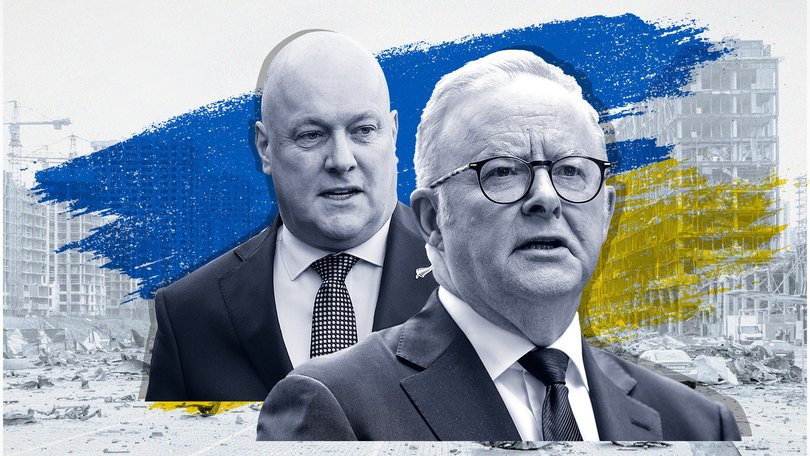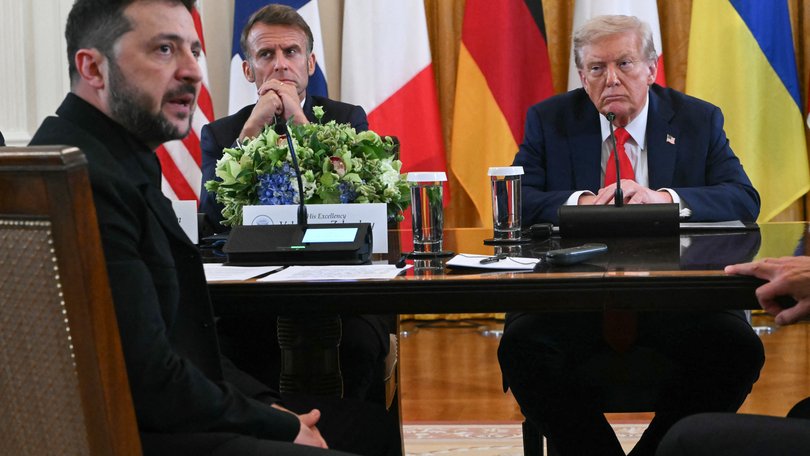Australia inches towards an Anzac peacekeeping force for Ukraine

International leaders, including Anthony Albanese, held a video call overnight that could eventually lead to the deployment of Australian soldiers to enforce a ceasefire or peace agreement in Ukraine.
In a sign that plans to create a multi-national force to protect the war-ravaged country are accelerating, more than 30 prime ministers, presidents and senior officials joined Ukrainian President Volodymyr Zelensky late Tuesday to discuss what British Prime Minister Keir Starmer said would be “a reassurance force” designed to prevent further Russian aggression.
Earlier on Tuesday President Donald Trump indicated that he does not want American ground troops on Ukrainian soil, but would consider providing air support. His position puts the onus on Europe and allies such as Australia, Canada and Japan, to provide soldiers who could be used to enforce some kind of peace deal.
Sign up to The Nightly's newsletters.
Get the first look at the digital newspaper, curated daily stories and breaking headlines delivered to your inbox.
By continuing you agree to our Terms and Privacy Policy.Those soldiers would not operate as a buffer force between Russian and Ukraine along any ceasefire line, a mission that might require tens of thousands of soldiers spread over 1000km, the Wall Street Journal reported. Instead, they could man strategically important locations, including airports and military bases, to deter Russian attacks. The French government has offered 3,000 and 5,000 troops initially, the paper said.
US Air Force
Australia’s potential commitment is unclear. Western forces would not be sent until both sides stopped fighting, participants indicated, a development that has not come close in three years of war. European leaders, including NATO Secretary Mark Rutte, met in the Oval Office on Monday to try to persuade Mr Trump not to give up on Ukraine.
The Europeans are willing to lead an international mission, but want guarantees America’s huge military forces will be available to help if Russia tries to intimidate or provoke a fight with them.
Asked earlier this week if Australia would participate in a peacekeeping mission, Mr Albanese was non-committal. “That would be a matter for the cabinet,” he said.

After Tuesday night’s call he wrote on X: “Australia welcomes ongoing efforts towards achieving a just and enduring peace, including yesterday’s discussions in Washington.”
In March Mr Albanese said any contribution would be small. His decision to participate in Tuesday night’s meeting of what the participants have dubbed the “Coalition of the willing” suggests that an Australian contribution is being actively considered.
Australia has participated in dozens of peacekeeping missions since 1947, including in East Timor, the Solomon Islands and Cambodia. But sending military personnel into a European conflict might be at odds with Australia’s focus on security in the local region, including the rise of China.
“It would be Australia balancing priorities with the Indo-Pacific with wanting to support NATO partners,” said Shannon Zimmerman, a lecturer at Deakin University who specialises in peacekeeping. “We would be highly unlikely to do it without Russian agreement.”
Potential
Ukraine’s ambassador to Australia, Vasyl Myroshnychenko, said he expected any request for Australian forces to be made by Britain, which is coordinating the coalition. “There is that potential that can happen but before it happens lots of things have to happen, including a ceasefire,” he said Wednesday morning.
A participant on the leaders’ call included New Zealand Prime Minister Christopher Luxon, who has previously said he is been open to participating in a peacekeeping mission.
The first step would be some kind of agreement between Russia and Ukraine. On Monday Mr Trump said he called Russian President Vladimir Putin and “began the arrangements for a meeting” with Mr Zelensky. Russia has not confirmed whether Mr Putin is willing to see the leader he has denigrated as an illegitimate head of state.
Mr Zelensky implied he would be open to a meeting with the Russian president for the first time since the February, 2022, invasion. “If Russia proposed to the President of the United States a bilat (bilateral meeting), then we will see the result,” he said this week. “Ukraine will never stop on the way to peace.”
Russia wants Ukraine to give up approximately 20 per cent of its territory and shrink its military forces. Ukraine wants assurances from NATO it will be protected from future Russian aggression.

